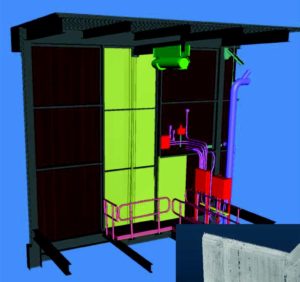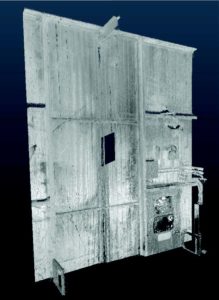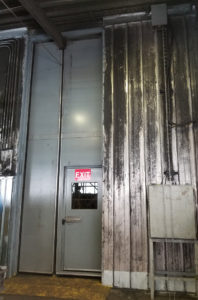When Acensium, a respected engineering firm known for its design and 3D scanning expertise in material handling and project oversight for the power industry, was asked by its customer to help upgrade some doors in its coal plant, it joined forces with PS Access Solutions™. Together, these two companies ended up building a door like no other.
Acensium’s customer (a large utility) had launched an initiative to reduce the spread and accumulation of combustible dust in one of its coal-fired power plants. A specific area of concern was its Tripper Room: a 700-foot-long chamber where the opportunity for coal dust generation and accumulation was problematic due to the high volume of coal being transferred.
Acensium performed a combustible dust audit and analysis of the room using 3D laser scanning technology. 3D scans allow detailed computer simulations that can be analyzed for opportunities to mitigate and eliminate dust generation. 3D scans can also ensure that all openings are sealed tightly. After carefully analyzing the results of the audit, the Acensium team determined that the facility needed several new industrial sliding doors. There was one opening, however, that called for a more custom approach, and Acensium looked to PS Access Solutions to join the project.
 3D scans are key tools for project risk management. The scans can be used to identify any infrastructure (e.g., a piece of conduit, a fire extinguisher, etc.) that might hinder the installation or execution of solutions, specifically the installation of critical new doors.
3D scans are key tools for project risk management. The scans can be used to identify any infrastructure (e.g., a piece of conduit, a fire extinguisher, etc.) that might hinder the installation or execution of solutions, specifically the installation of critical new doors.
“In our long history of working with coal transfer systems, many customers have specified PS Access Solutions in their requests,” says Rowan Connelly, general manager at Acensium. “So we’ve worked with them several times. While past projects with PS Access Solutions mostly involved small access door hatches, this project called for something much larger and more complicated. We knew that they could help us to develop a solution even if it was unique and challenging.”
The Tripper Room has a large entrance that includes a significant number of elements that could interfere with the installation of a traditional industrial door. A large open hoist shaft and critical electrical infrastructure built close to the outside of
 the door meant that opening mechanisms needed to be located inside the Tripper Room. Due to the generation of dust in the Tripper Room, this presented a significant design hurdle. In addition, there was a hoist beam running off-center through the top of the door opening, which meant that the door would need two asymmetrical panels almost 20 feet high to close around it in order to form a seal. The main door also needed to remain shut while still allowing foot traffic to pass through it.
the door meant that opening mechanisms needed to be located inside the Tripper Room. Due to the generation of dust in the Tripper Room, this presented a significant design hurdle. In addition, there was a hoist beam running off-center through the top of the door opening, which meant that the door would need two asymmetrical panels almost 20 feet high to close around it in order to form a seal. The main door also needed to remain shut while still allowing foot traffic to pass through it.
Acensium and PS Access Solutions worked together closely to develop a solution. “This was one of the most complicated openings we’ve ever had to work with,” says Connelly. “We needed a partner who was specialized in creating custom doors, and we were glad to have PS Access Solutions on our team. You could tell that everyone was excited to work on something so unique.”
Through hard work and close collaboration, the two companies designed and manufactured a custom monorail sliding door. The door is made up of two large panels, one of which includes a pedestrian swing door set into it. Due to the size of the panels and the layout of the plant, the two main panels had to be split into four sections in order to install them at the entrance. Once the parts were maneuvered through the plant, the four panels were then bolted back together.
 The monorail door is opened by utilizing a large hand chain. These are typically installed on the outside of a door, but with the unique interference challenges presented on the entrance’s exterior, this one had to be reconfigured for the interior of the Tripper Room. Acensium designed a steel hood to conceal and protect the gear mechanism at the top of the opening by allowing dust to slide off instead of interfering with the mechanism. Because the door panels are asymmetrical, the larger panel needs more time to open fully, which means the smaller panel has to open farther to compensate. The hand chain was configured in such a way to accommodate this as well, allowing the monorail door to close evenly and seal tightly every time.
The monorail door is opened by utilizing a large hand chain. These are typically installed on the outside of a door, but with the unique interference challenges presented on the entrance’s exterior, this one had to be reconfigured for the interior of the Tripper Room. Acensium designed a steel hood to conceal and protect the gear mechanism at the top of the opening by allowing dust to slide off instead of interfering with the mechanism. Because the door panels are asymmetrical, the larger panel needs more time to open fully, which means the smaller panel has to open farther to compensate. The hand chain was configured in such a way to accommodate this as well, allowing the monorail door to close evenly and seal tightly every time.
The project started in August of 2017 and wrapped up in December of that same year. “Teamwork was critical for the success of this project,” says Connelly. “The team was enthusiastic about finding solutions to every challenge that came our way, and this project was incredibly successful because of it. We’re looking forward to working with PS Access Solutions again in the future.”
To learn more about Acensium, visit www.acensium.com.
To learn more about PS Access Solutions products, visit psaccesssolutions.com or contact Chris Handlos at 877-446-1519 or 701-795-6569.